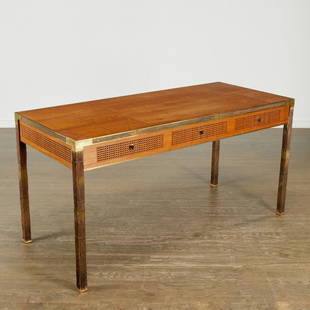

 Discovery- InteriorsBonhamsSponsored.Your ad here?
Discovery- InteriorsBonhamsSponsored.Your ad here?



Discovery- Interiors
Bonhams
Sponsored.Your ad here?


 Discovery- InteriorsBonhamsSponsored.Your ad here?
Discovery- InteriorsBonhamsSponsored.Your ad here?



Discovery- Interiors
Bonhams
Sponsored.Your ad here?

Egyptian Bronze Cat + Apis Bull, ex Parke-Bernet
Similar Sale History
View More Items in FashionRelated Fashion
More Items in Fashion
View More




Item Details
Description
Egypt, Late Dynastic to Ptolemaic Period, ca. 664 to 30 BCE. A striking pair of cast-bronze figures from ancient Egypt; a cat and an Apis bull. Seated upon its plump haunches with its sinuous tail wrapped around its hind legs and forepaws, the feline relaxes with its back gently arched and its chest protruding forward in a patient, defensive pose with its weight leaned over the front legs as if ready to strike at the first mouse it sees. The head rests atop a tapered neck and features a charming countenance defined by almond-shaped eyes, a round snout, a thin mouth, and a pair of petite ears. Alternatively, the Egyptian bull represents the god Apis. He wears a sun disk surrounded by large bull horns - a crown commonly associated with the deities Hathor and Isis - presented with a frontal uraeus. Apis stands in profile on four hooved legs atop an integral plinth, his muscular body gradually tapering to a downcast bovine head, with a slender tail and delineated genitalia between his back legs. Beautiful seafoam green and russet patina envelops both figures. Size of largest (cat): 0.5" W x 2.3" H (1.3 cm x 5.8 cm); 3.25" H (8.3 cm) on included custom stand.
This cat probably represents the goddess Bastet, who represented fertility and motherhood. Thousands of mummified cats and kittens were given as offerings to Bastet at temples in her honor. Beyond the goddess, cats, known in ancient Egypt as "mau," were honored and protected in Egyptian society. Famously, Herodotus wrote that in Egypt, men would protect cats from fire, and that when a cat died, a household would go into mourning as if a human member of the family had died, shaving their eyebrows to signify their loss. It was immediately before this Late Dynastic Period that worship of Bastet became immensely popular, and her chief center of worship, Bubastis, became a great city.
Apis was originally worshipped by Narmer, the ruler who unified Upper and Lower Egypt around 3000 BCE; the sacred bull is shown trampling the pharaoh's enemies on the Narmer palette that commemorates the unification. Three thousand years later, by the time of Roman control of Egypt, the worship continued. Though centered around the city of Memphis, the cult of Apis was so extensive in Egypt that the Greeks and Romans wrote about it repeatedly. The famous French archaeologist Mariette, excavating at the Serapeum of Saqqara, found the mummified remains of more than sixty bulls, some buried in their own separate tombs.
Provenance: ex-private Bergen County, New Jersey, USA collection; ex-Parke-Bernet Galleries, part of lot 171, from the January 8th, 1970 auction, Antiquities & Ethnographical Arts
All items legal to buy/sell under U.S. Statute covering cultural patrimony Code 2600, CHAPTER 14, and are guaranteed to be as described or your money back.
A Certificate of Authenticity will accompany all winning bids.
We ship worldwide to most countries and handle all shipping in-house for your convenience.
#163094
This cat probably represents the goddess Bastet, who represented fertility and motherhood. Thousands of mummified cats and kittens were given as offerings to Bastet at temples in her honor. Beyond the goddess, cats, known in ancient Egypt as "mau," were honored and protected in Egyptian society. Famously, Herodotus wrote that in Egypt, men would protect cats from fire, and that when a cat died, a household would go into mourning as if a human member of the family had died, shaving their eyebrows to signify their loss. It was immediately before this Late Dynastic Period that worship of Bastet became immensely popular, and her chief center of worship, Bubastis, became a great city.
Apis was originally worshipped by Narmer, the ruler who unified Upper and Lower Egypt around 3000 BCE; the sacred bull is shown trampling the pharaoh's enemies on the Narmer palette that commemorates the unification. Three thousand years later, by the time of Roman control of Egypt, the worship continued. Though centered around the city of Memphis, the cult of Apis was so extensive in Egypt that the Greeks and Romans wrote about it repeatedly. The famous French archaeologist Mariette, excavating at the Serapeum of Saqqara, found the mummified remains of more than sixty bulls, some buried in their own separate tombs.
Provenance: ex-private Bergen County, New Jersey, USA collection; ex-Parke-Bernet Galleries, part of lot 171, from the January 8th, 1970 auction, Antiquities & Ethnographical Arts
All items legal to buy/sell under U.S. Statute covering cultural patrimony Code 2600, CHAPTER 14, and are guaranteed to be as described or your money back.
A Certificate of Authenticity will accompany all winning bids.
We ship worldwide to most countries and handle all shipping in-house for your convenience.
#163094
Condition
Losses to midsection of bull's leg and cat's plinth. Expected nicks, abrasions, and softening of detail commensurate with age. Otherwise, excellent with lovely earthen deposits throughout and beautiful seafoam green and russet patina.
Buyer's Premium
- 24.5%
Egyptian Bronze Cat + Apis Bull, ex Parke-Bernet
Estimate $2,800 - $4,000
2 bidders are watching this item.
Shipping & Pickup Options
Item located in Louisville, CO, usOffers In-House Shipping
Local Pickup Available
Payment

Related Searches
TOP































































